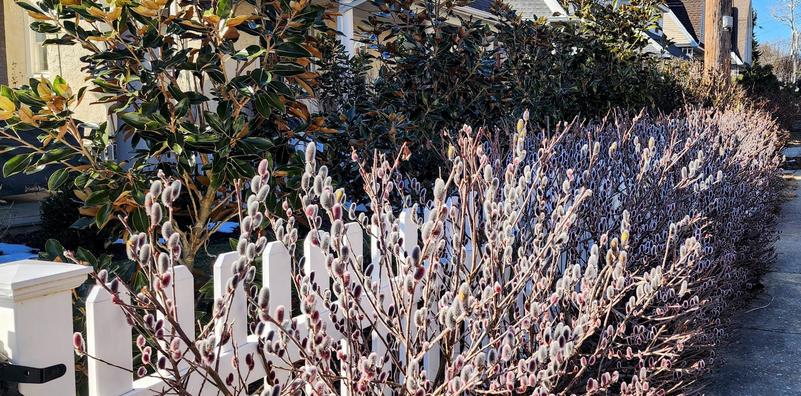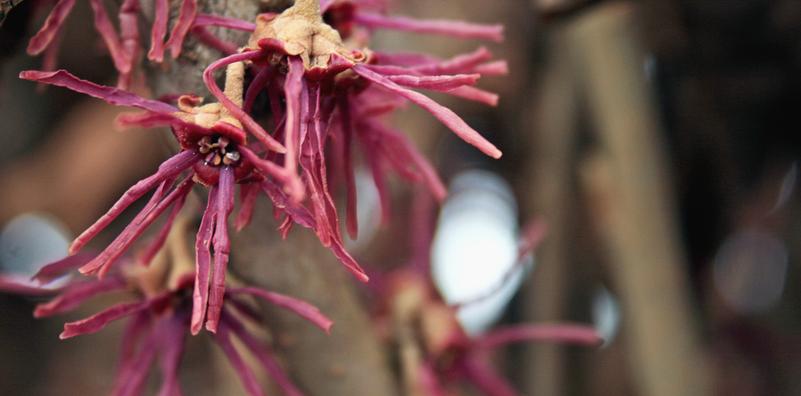Flowers & Fragrances of February
Believe it or not, there’s quite a bit to see around the Nursery right now – we have perennials gently emerging from their winter slumbers, pushing tentative basal foliage above the soil line, and winter-blooming shrubs performing their annual routine. If you know where to look, there are wintry happenings subtly making themselves known in preparation for what we are anticipating to be a very busy spring season. While the weather is still (kinda) cold and the trees remain bare, let’s take a look at some of the fun findings from this week in production.
Naturally, vernal witch hazel, also sometimes called Ozark witch hazel, is always ready to make a statement in the winter garden this time of year and our Hamamelis vernalis ‘Purple Ribbons’ is living up to its expectations. The spidery, plum purple inflorescences tinged with orange ends are partially responsible for the otherworldly fragrance that overwhelms their cold frame right now (Hamamelis vernalis ‘Autumn Embers’ is equally as fragrant despite being towards the end of its bloom period). Perfect for adding a shock of fragrance to the rain or wetland garden, or even for an early season specimen in the sensory garden, Hamamelis vernalis ‘Purple Ribbons’ is a wildly versatile, deer resistant selection that can not only tolerate clay soils, but the presence of juglone produced by black walnut trees, as well as salt-prone and shady conditions. Following its growing period, come fall, the foliage takes on a rainbow of color, rounding out basically every season with a point of visual (or aromatic) interest.
Speaking of aromatic flowers, Sarcococca hookeriana var. humilis ‘Fragrant Valley’ is like a punch in the nose of absolutely delightful fragrance. It’s really no wonder why this plant’s common name is sweetbox – its small, demure stature and evergreen foliage give it the same appeal as a low-growing boxwood hedge, with the added benefit of fragrant wintertime blooms that literally knock your socks off. Being in the presence of a sweetbox patch really makes one pause and embrace the experience, no matter how familiar they may be with its sweet, all-encompassing perfume. There is quite a lovely patch of sweetbox at Ambler Arboretum of Temple University, which can be noticed by its potent fragrance from several yards away before the small hedge bordering a rock wall can be seen. Although the flowers themselves are rather inconspicuous, the aroma invites further inspection of the shrub, and upon investigation one will find the flowers to be quite charming.
Inconspicuous blooms are much more overlooked than they ought to be, in our honest opinion. Despite the seasonal trim that a majority of our Carex species have undergone, several of them are beginning to display their fluffy, cattail-like inflorescences, which are often not the reason that many sedges are planted. While many sedge varieties are chosen for their foliage or ability to act as lawn-replacements, the inflorescence-units (often referred to as “spikes”, or “spikelets”) should be considered in the landscape for their textural interest as well as their relationship with native pollinators. While several of our sedge species are beginning to push both foliage and floral structures all at once, a couple of them have exploded with floral growth that’s hard to ignore. Among them, Japanese Carex oshimensis ‘Everillo’ and Mid-Atlantic native Carex plantaginea have caught our eye. With various Carex having recently procured Mt. Cuba Center’s seal of approval through their trial studies, what better way to pay homage to underutilized sedges than showcasing them in bloom? While these two are only a small sample of our rather diverse Carex selection, including both native and ornamental non-natives, they are prime examples of the underappreciated floral structures that are part of what make this genus so interesting.
Finally, would a February newsletter be complete without a few snapshots of our fluffy pussy willow catkins in bloom? Both the Salix chaenomeloides along our bioswales as well as Salix gracilistyla ‘Mt. Aso’ within production are in full display, inviting curious hands to explore the satisfyingly fluffy inflorescences. As with the above fragrant shrubs, Hamamelis vernalis ‘Purple Ribbons’ and Sarcococca hookeriana var. humilis ‘Fragrant Valley’, adding the silky catkins to a sensory garden or healing garden encourages the sensation of touch, especially for adventurous children, or individuals with sight or hearing disabilities. Simply the act of playing with the fleecy blossoms is enough to inspire a childlike whimsy, and seeing a collection of ‘Mt. Aso’ pussy willows bloom in tandem, as would be seen in a hedge, evokes a combination of feelings: from calm contentment, to happiness, to curiosity. Molly Patnik, owner and designer of Deep Roots Gardening in Pennsylvania, sent us a photo of a very happy and established installation of Salix gracilistyla ‘Mt. Aso’ in an outrageous full bloom performance, backed by some equally happy Magnolia grandiflora ‘Little Gem’ specimens that are creating an absolutely stunning hedge. Thanks, Molly!
Have an installation of our plants that you want us to shout out on our weekly email? Feel free to send your pictures to kate@pleasantrunnursery.com or info@pleasantrunnursery.com so that that world can see your work (and our plants!) in all their glory.
Carex oshimensis 'Everillo' - Plant Finder (missouribotanicalgarden.org)
Super Sedges: Using North American Carex in the Garden - Horticulture (hortmag.com)
A Comparative Study of the Inflorescence in the Genus Carex (Cyperaceae) (bioone.org)
Hamamelis vernalis 'Purple Ribbons' | Chicago Botanic Garden
Hamamelis vernalis - Plant Finder (missouribotanicalgarden.org)

Salix gracilistyla 'Mt. Aso' (Photo: Molly Patnik of Deep Roots Gardening)

